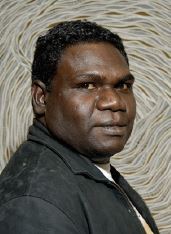Has mainly lived and worked as an artist at Ganggan, sometimes based at Dhuruputjpi or Yilpara. Gunybi is a ceremonial yidaki player who is sought after by elders. Accompanied the Yolngu delegations to the opening of the National Museum in Canberra 2001 and the larrakitj installation at the Sydney Opera House 2002, and played at the opening of Djambawa Marawili's exhibition in the 2006 Sydney Biennale.
Under the tutelage of artists like Gawirring Gumana and Yumutjin Wunungmurra from his mother's Dhalwangu clan whilst living on their country he has now assumed ceremonial authority.
He first came to the notice of the Buku-Larrnggay staff as an artist with a carved and painted Ironwood sculpture of a Wurran or cormorant (a totemic species of his mother clan) in 2002. The wood’s natural shape suggested itself to him and he commenced to reveal the bird within. He then added pigment to achieve the colouring but both sculpting Ironwood for sale (rather than ceremony) and painting Ironwood are new actions in North East Arnhem land public art. This began a consistent theme of Gunybi following his own inclinations in expressing his vision.
He has combined that with a startling innovative flair to produce groundbreaking sacred art that is at once novel and still entirely consistent with Yolngu madayin (law).
His first recognition in a wider sphere was when he was invited by Brenda Croft of the National Gallery of Australia to enter the National Sculpture Prize in 2005. He submitted one of his first sculpted larrakitj.
In the year of 2008 he was chosen as an exhibiting finalist in the Xstrata Coal Emerging Indigenous Artist Award at the Gallery of Modern Art at Queensland Art Gallery. He went on to win that Award.
Gunybi has had the instinct to introduce radical new forms without offending community tolerance. He has introduced or developed novel forms such as double sided barks, heavily sculpted poles, incised barks, ironwood sculpture, inserting sculptures into poles.
Gunybi is an energetic participant in ceremonial life who is always cheerful with a robust sense of humour. He is a natural leader amongst his peers. His vigorous zest for life sees him throw himself into whatever activity he is engaged in. He is married to Lamangirra Marawili, a daughter of Djambawa Marawili.
Has mainly lived and worked as an artist at Ganggan, sometimes based at Dhuruputjpi or Yilpara. Gunybi is a ceremonial yidaki player who is sought after by elders. Accompanied the Yolngu delegations to the opening of the National Museum in Canberra 2001 and the larrakitj installation at the Sydney Opera House 2002, and played at the opening of Djambawa Marawili's exhibition in the 2006 Sydney Biennale.
Under the tutelage of artists like Gawirring Gumana and Yumutjin Wunungmurra from his mother's Dhalwangu clan whilst living on their country he has now assumed ceremonial authority.
He first came to the notice of the Buku-Larrnggay staff as an artist with a carved and painted Ironwood sculpture of a Wurran or cormorant (a totemic species of his mother clan) in 2002. The wood’s natural shape suggested itself to him and he commenced to reveal the bird within. He then added pigment to achieve the colouring but both sculpting Ironwood for sale (rather than ceremony) and painting Ironwood are new actions in North East Arnhem land public art. This began a consistent theme of Gunybi following his own inclinations in expressing his vision.
He has combined that with a startling innovative flair to produce groundbreaking sacred art that is at once novel and still entirely consistent with Yolngu madayin (law).
His first recognition in a wider sphere was when he was invited by Brenda Croft of the National Gallery of Australia to enter the National Sculpture Prize in 2005. He submitted one of his first sculpted larrakitj.
In the year of 2008 he was chosen as an exhibiting finalist in the Xstrata Coal Emerging Indigenous Artist Award at the Gallery of Modern Art at Queensland Art Gallery. He went on to win that Award.
Gunybi has had the instinct to introduce radical new forms without offending community tolerance. He has introduced or developed novel forms such as double sided barks, heavily sculpted poles, incised barks, ironwood sculpture, inserting sculptures into poles.
Gunybi is an energetic participant in ceremonial life who is always cheerful with a robust sense of humour. He is a natural leader amongst his peers. His vigorous zest for life sees him throw himself into whatever activity he is engaged in. He is married to Lamangirra Marawili, a daughter of Djambawa Marawili.
